Amersham Gas Works
by Peter Healy
Amersham Gas Works, which was on the site off the Broadway, Old Amersham, now occupied by St. Mary’s Court, was regarded as an eyesore in the period before it was demolished in 1994. Two large gas holders were a bit of a ‘blot on the landscape’ and, following gas conversion in the 1970s, were seldom used for gas storage. However, we should remember that, when Amersham Gas works was established, in the 1850s, it liberated local householders from lighting by whale oil, tallow or candles and gave them well lit houses and streets in the period before electricity and electric lighting became standard, around the start of World War I. In this period (1830s to 1900), gas was almost exclusively used for lighting with cooking undertaken on open or closed range cookers and heating supplied by open coal or wood fires.
 The Amersham Gas Light & Coke Company, who constructed and ran Amersham Gas Works, for the first 51 years of its existence, was established by a Deed of Settlement drawn up and signed in 1855 (the original deed is in the Amersham Museum collection). The incorporation of Gas Light & Coke in the name mirrored the original Gas Light & Coke Company, founded in 1812 in London to supply gas to the area north of Thames. It was the world’s first gas company and precursor, on gas nationalisation, of the North Thames Gas Board which supplied gas to the Amersham area.
The Amersham Gas Light & Coke Company, who constructed and ran Amersham Gas Works, for the first 51 years of its existence, was established by a Deed of Settlement drawn up and signed in 1855 (the original deed is in the Amersham Museum collection). The incorporation of Gas Light & Coke in the name mirrored the original Gas Light & Coke Company, founded in 1812 in London to supply gas to the area north of Thames. It was the world’s first gas company and precursor, on gas nationalisation, of the North Thames Gas Board which supplied gas to the Amersham area.
The initial 300 shares were priced at £5.00 each which raised £1500. Some 21 individuals purchased these shares of which William Weller, of Wellers Brewery in Church Street, Amersham and Herbert Ingram, papermaker and publisher were by far the largest shareholders. Herbert Ingram MP, who had a large house Glen Chess in Loudwater, Rickmansworth constructed for him in the mid-19th century, owned a papermaking business in Chesham and was the publisher of the Illustrated London News, a hugely successful pictorial magazine across this period which did not finally cease publication until 2003.
The board of directors, who were all shareholders, included William Weller and Herbert Ingram together with seven others with enough disposable income to afford a shareholding. Other officers of the company included James Christmas as a trustee (with Herbert Ingram) and William Broadwater as secretary.
In the 1850s and up to the UKs conversion to natural gas from 1968, the gas provided to customers was called Town or Coal gas. It was a mixture of hydrogen and methane with several other impurities in gas form. Each town gas works required gas retorts, in which coal was heated to liberate the gas. This was siphoned off and passed on to a condenser were it was captured. The waste product left in the retort was coke and, in many gas works, the coke was then burned to heat the retorts or sold as smokeless fuel. The gas needed to be stored because most gas production took place during the day but was burnt, for lighting, at night.
So, the first task of the fledging Amersham Gas Light & Coke Company was to create the three retorts initially used for gas production together with the first gas holder. The retorts were constructed by Messrs Bale and Hardy for £14 12s 3d but, as no minute books for the gas works have survived, we have no prices for the construction of the 1850s gas holder or for laying gas supplies to the affluent middle class houses which could afford the cost of the service and the fuel.
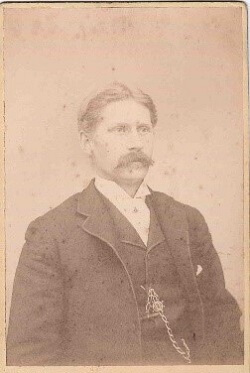
We have records (but not a complete record) of a number of the managers of Amersham Gas Works and these include:
1861 – William Plested
1881 – George Lewin
1883 – George Ward, who was involved in so many Amersham projects
at this time
1891 – Frederick Joseph Ward, George Ward’s brother pictured right
1894 – Anderson
1895 – F Bullock
1902 – A Turner
Managers of the Amersham Gas Works were expected to live in a house attached to the works and were paid around 20 to 25 shillings per a week for their work, They also had free gas lighting and, we suspect, free gas for appliances such as cookers and fires once these began to be sold by the company to its customers.
There is also information on the number of customers in the period 1899 to 1908. The figures in brackets are for those who used prepayment (coin in the slot to pay for the gas) rather than those who were billed monthly. The population of Amersham at this time was between 3129 to 3209.
1899 – 77
1901 – 103(27)
1902 – 130 (27)
1903 – 158 (28)
1905 – 111 (28)
1908 – 186 (80)
One use of gas, which would have pleased Amersham residents, was the provision of gas street lighting around the town. This first appeared in the 1890s and by 1903, there were 37 gas lamps which cost Amersham Rural District Council approximately £40 year to fund. In 1880 The company also agreed to supply gas for lighting to the Union Workhouse in Whielden Street with the meter costing the workhouse 10s per annum
The single initial gas holder of the 1850s was supplemented by a second gas holder in 1893 which was constructed by G Darlington, Builders and Undertakers of Amersham Common and Old Amersham. A picture of this gas holder shortly after construction is shown below.

It was in this period that new gas services were laid around the old town and up Station Road to Amersham Station. A further gas supply was run along the ‘cinder path’ (which still runs from Highover Park to the Hyrons humpback bridge) in order that gas lighting could be provided at the rear access to Amersham Station (from The Green). The pictures below show gas pipe installation in Whielden Street and adjacent to the Market Hall.
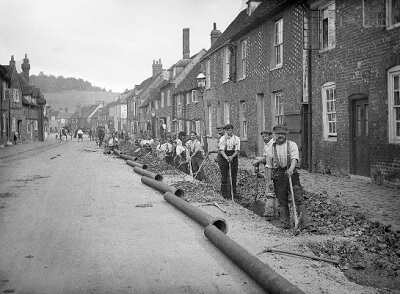

The Amersham Gas Light & Coke Company accounts for 1909
Although the Amersham Gas & Light & Coke company has turned down takeover overtures from individuals in the 1890s, a suggested amalgamation offer from Uxbridge Gas Company was accepted in 1910 with Amersham shareholders being offered just over the £5.00 value for each of their shares. This was translated into debenture shares with guaranteed interest of 4%. Under the Uxbridge Gas Company regime, a new gas holder was installed by Messrs C & A Walker presumably to replace the 1859 holder. Other activity in these early days of Uxbridge ownership were the laying of 5 ½ miles of gas main from Amersham to Sarratt which would have offered gas to Amersham Common and Little Chalfont.
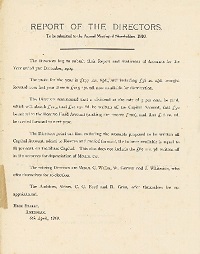
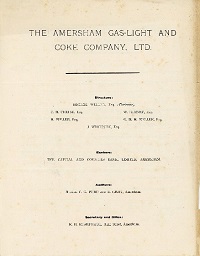
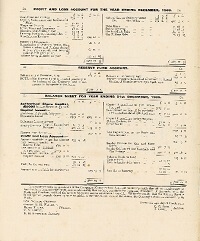
In 1920, the owners of the Uxbridge Gas Company acquired the High Wycombe Gas Light and Coke Co. and was renamed the Uxbridge, Wycombe and District Gas Co, an appellation it retained until the nationalisation of gas in 1948. From this latter date, the Amersham works became part of the North Thames Gas Board, one of the twelve nationalised gas utilities. Four years later, the gas works itself was deemed to ‘have reached the end of its life’ and it was dismantled over the next 2 years. However, the site was retained as a location for gas holders, which were important to meet peak gas demand and a new half-million cubic feet gas holder was bought in to operation in 1958. The conversion of the UK to natural gas in between 1968 and 1976 obviated the need for gas holders and the two on the gas works site were demolished in 1994.
For this history we have heavily drawn on the book The Gas Works of Buckinghamshire by Tony Marks to whom our thanks are due.

